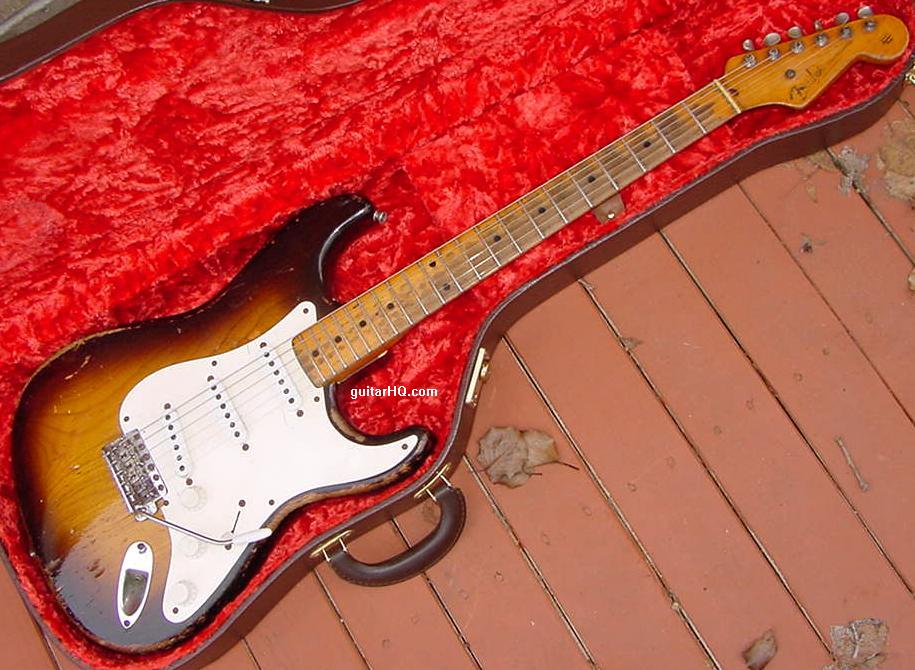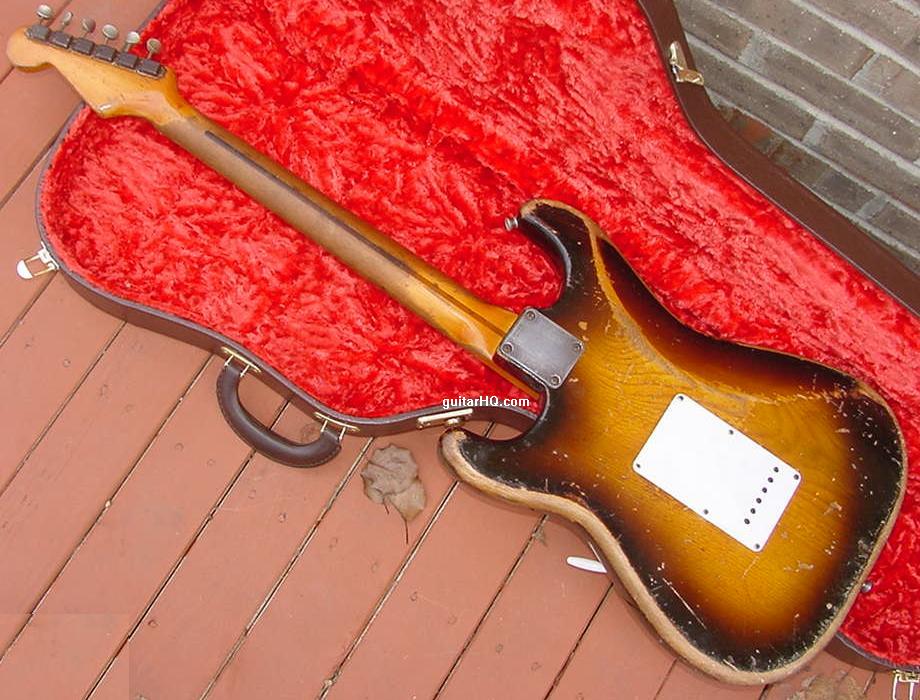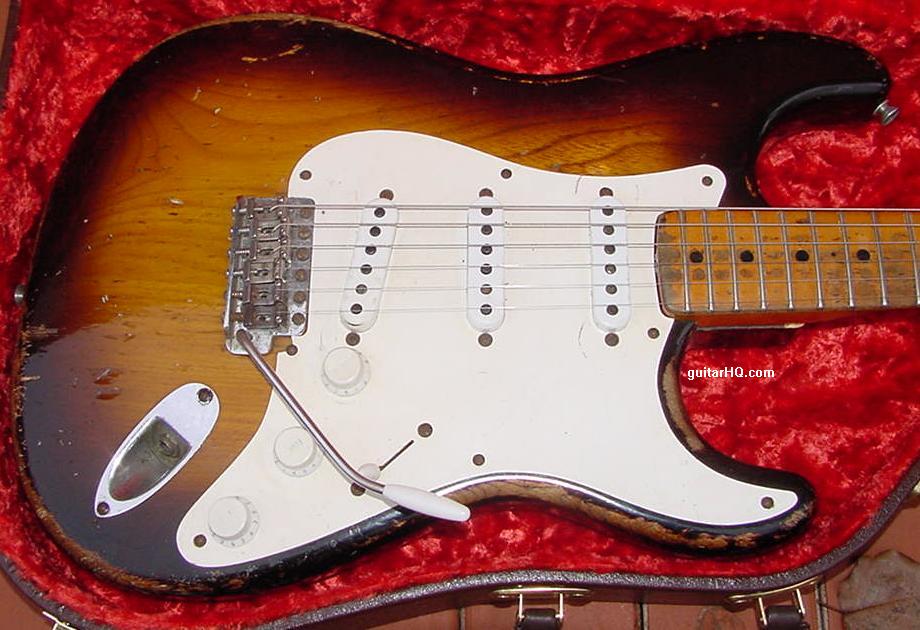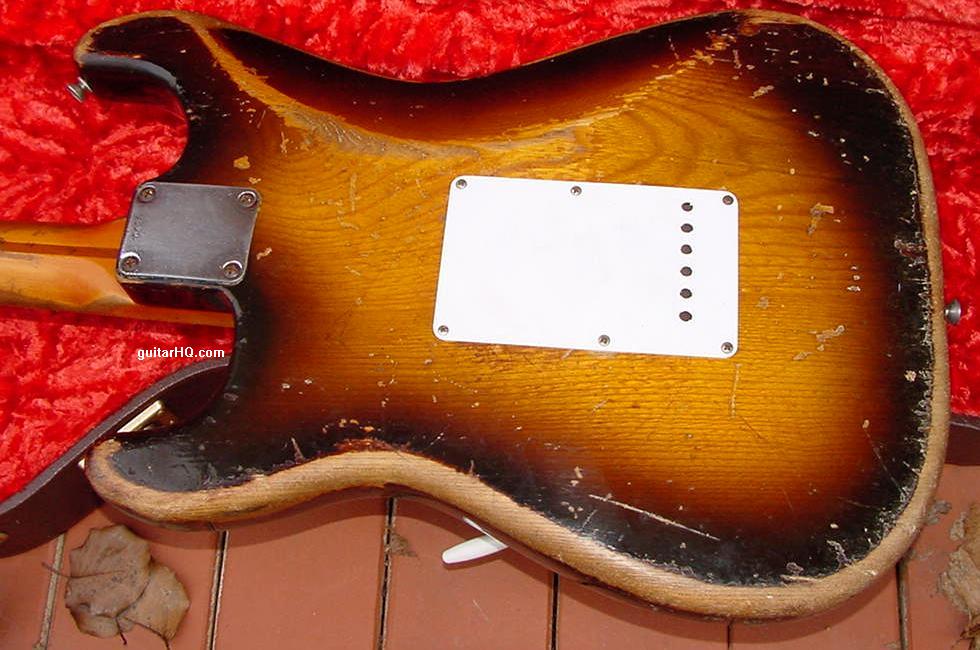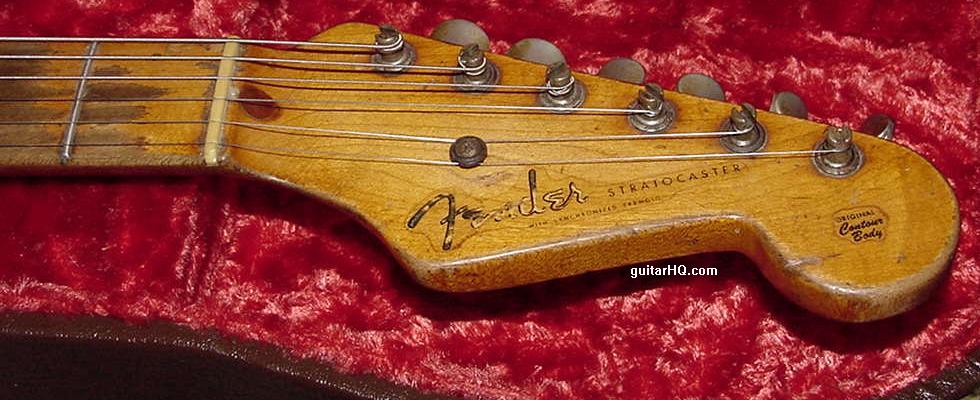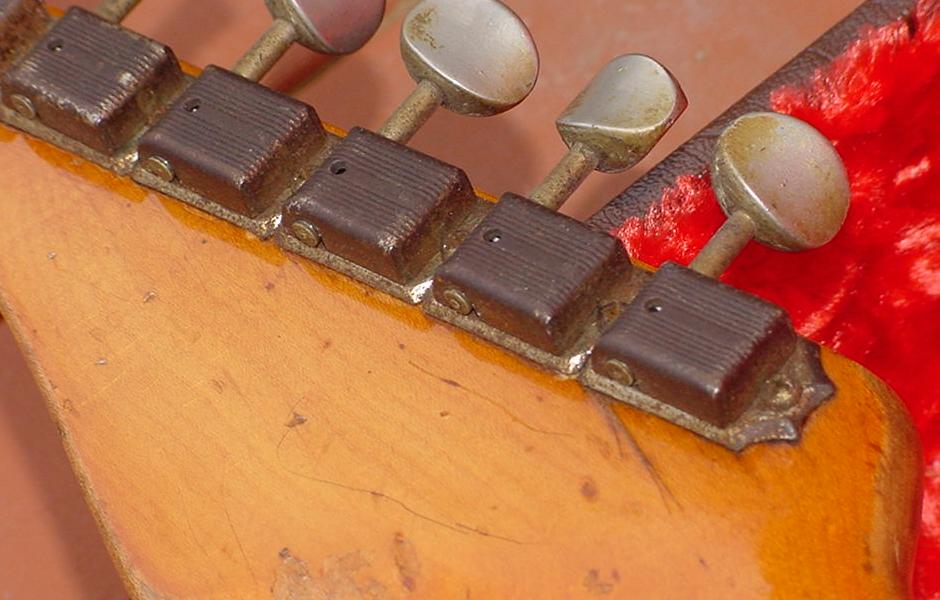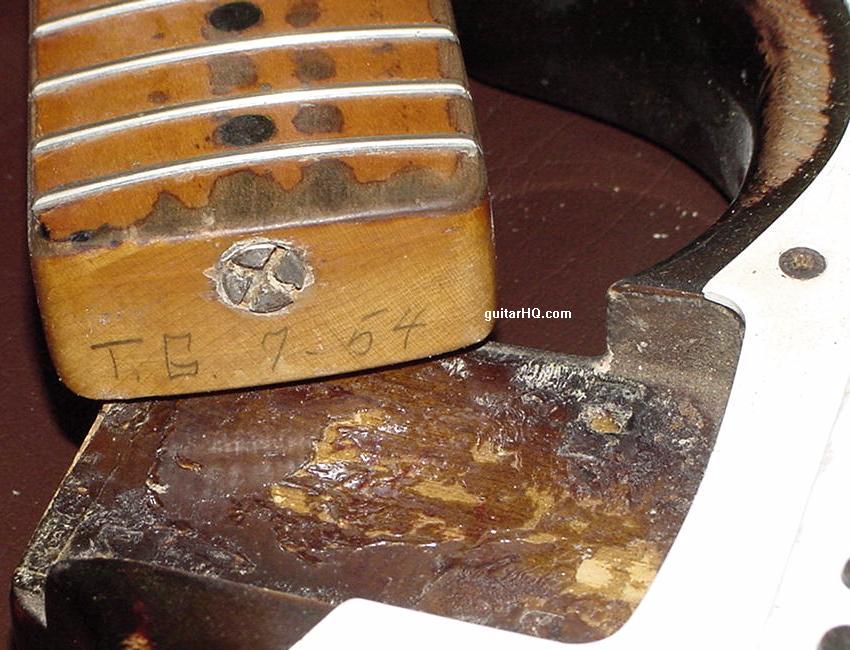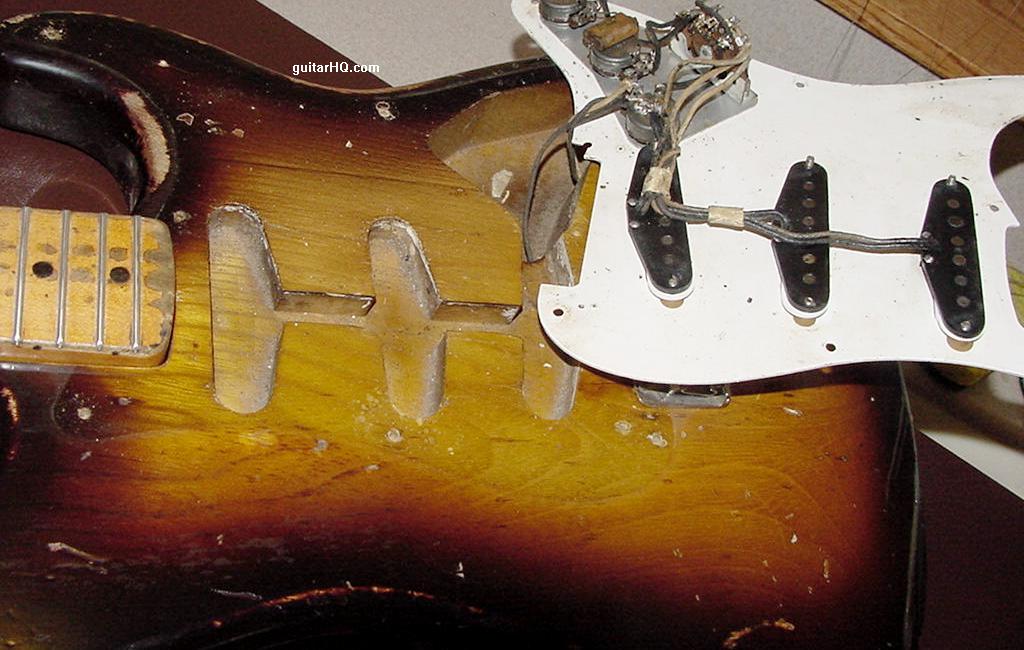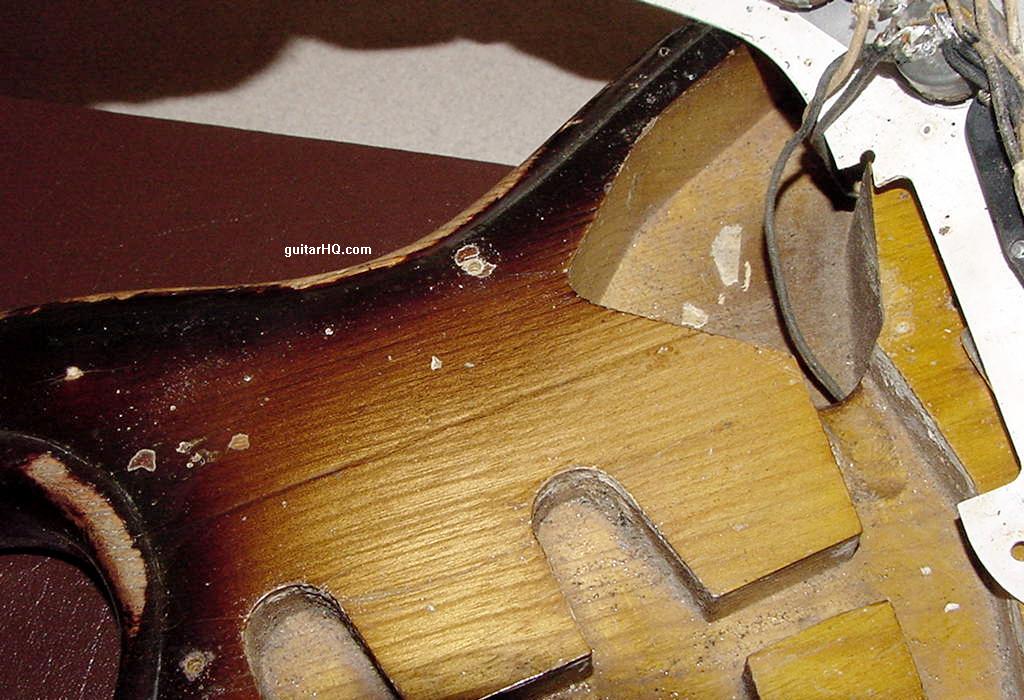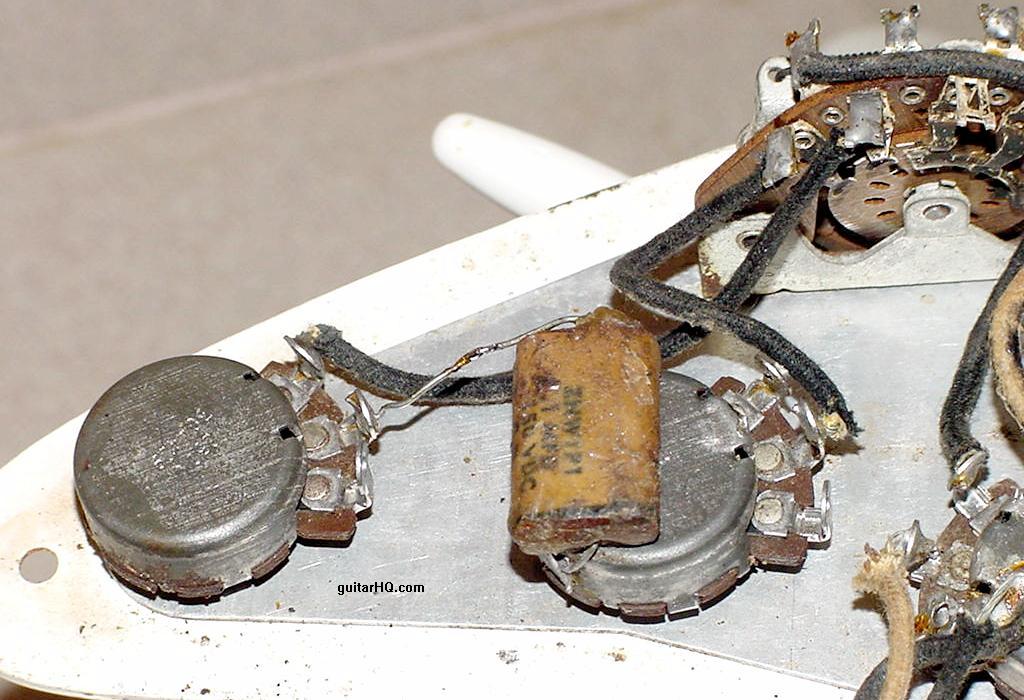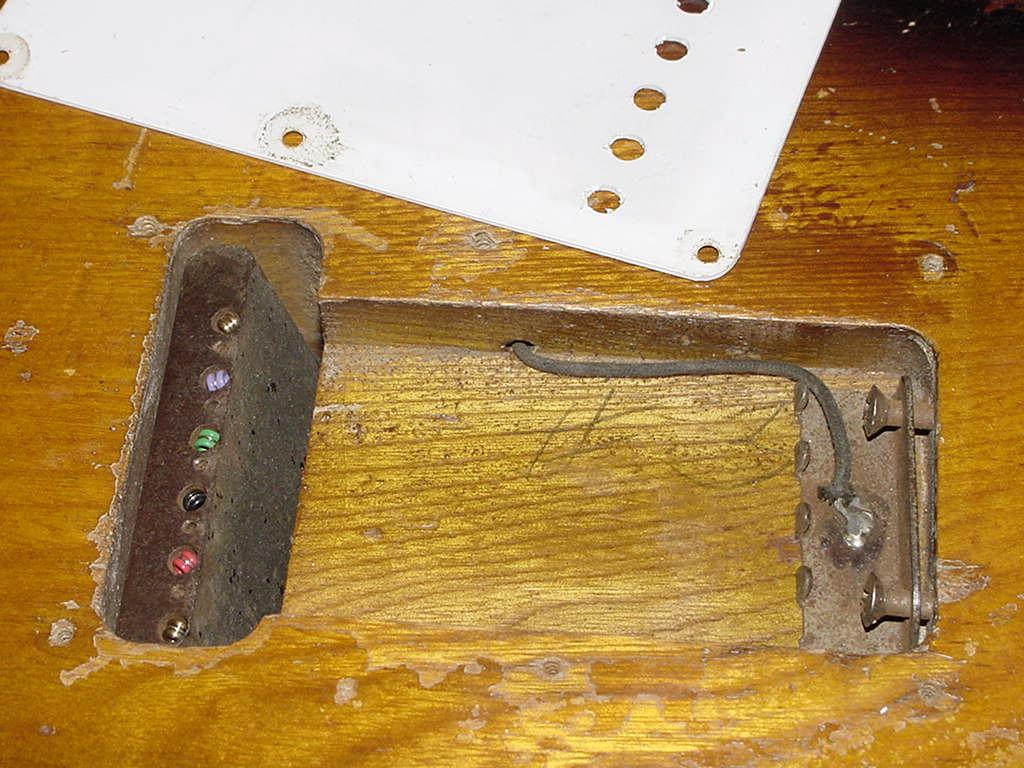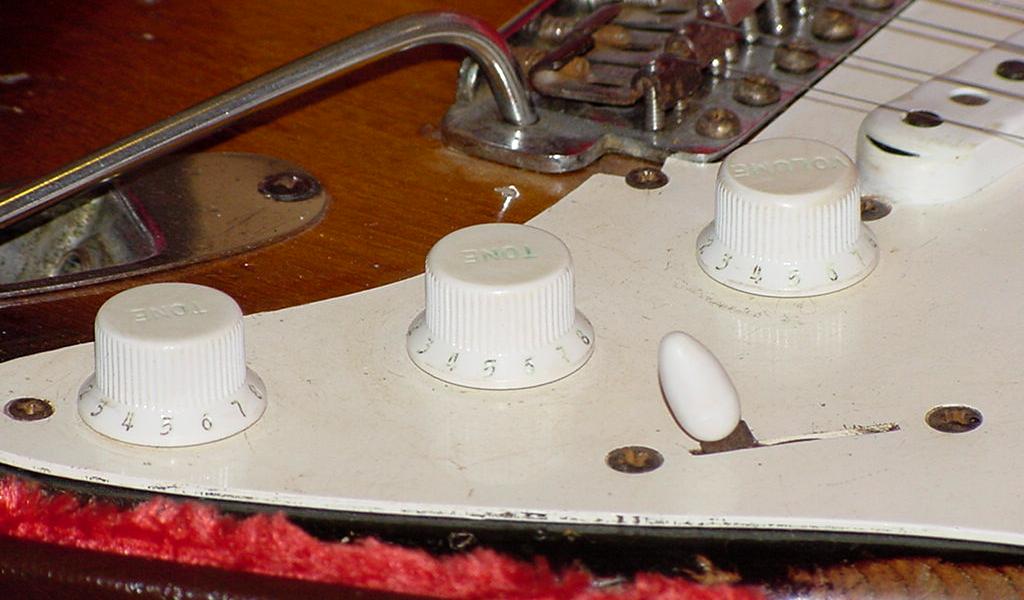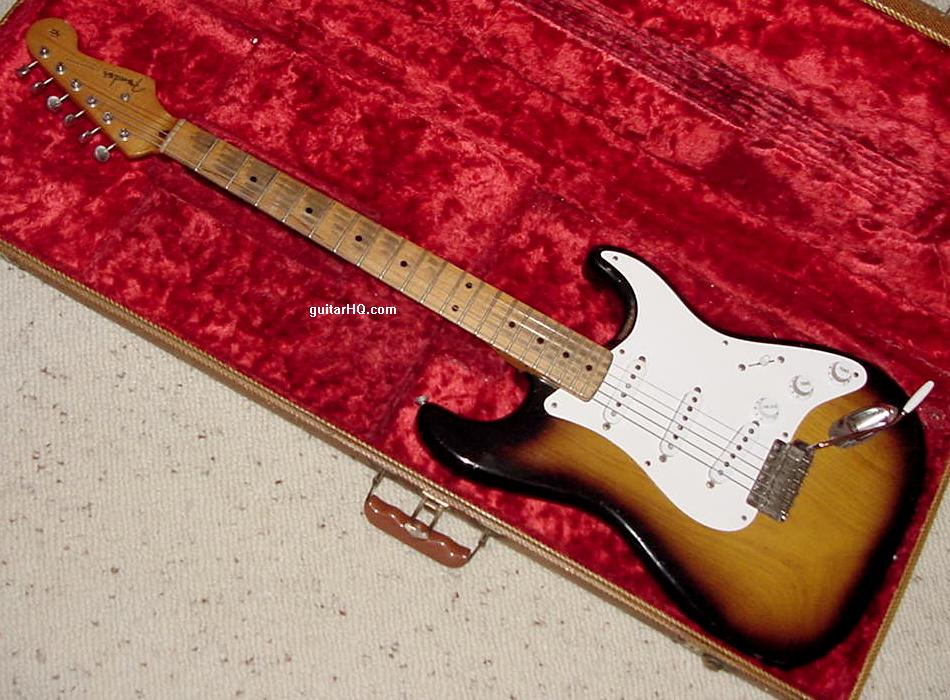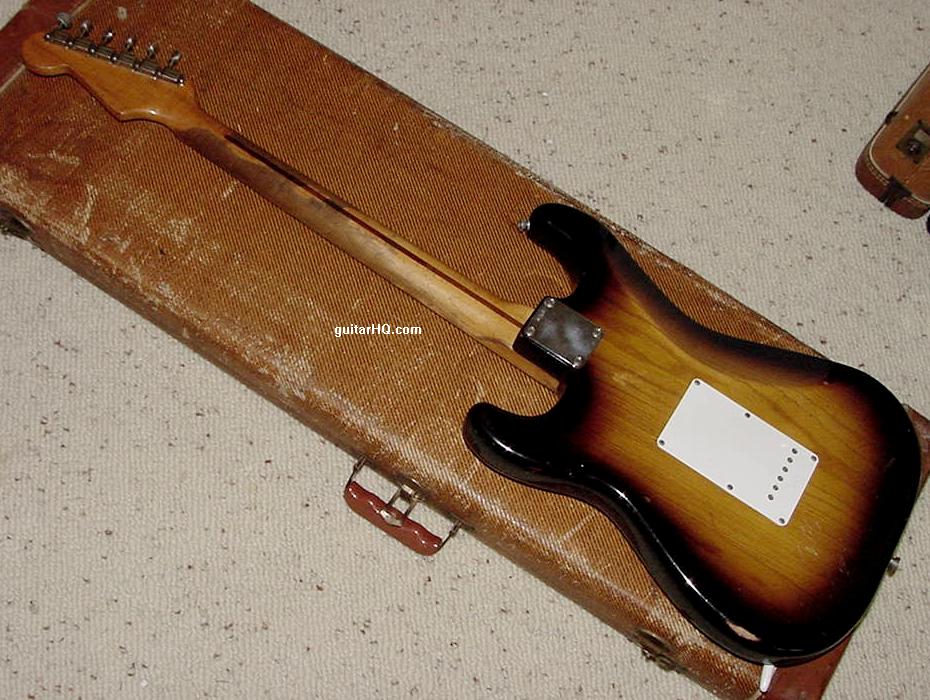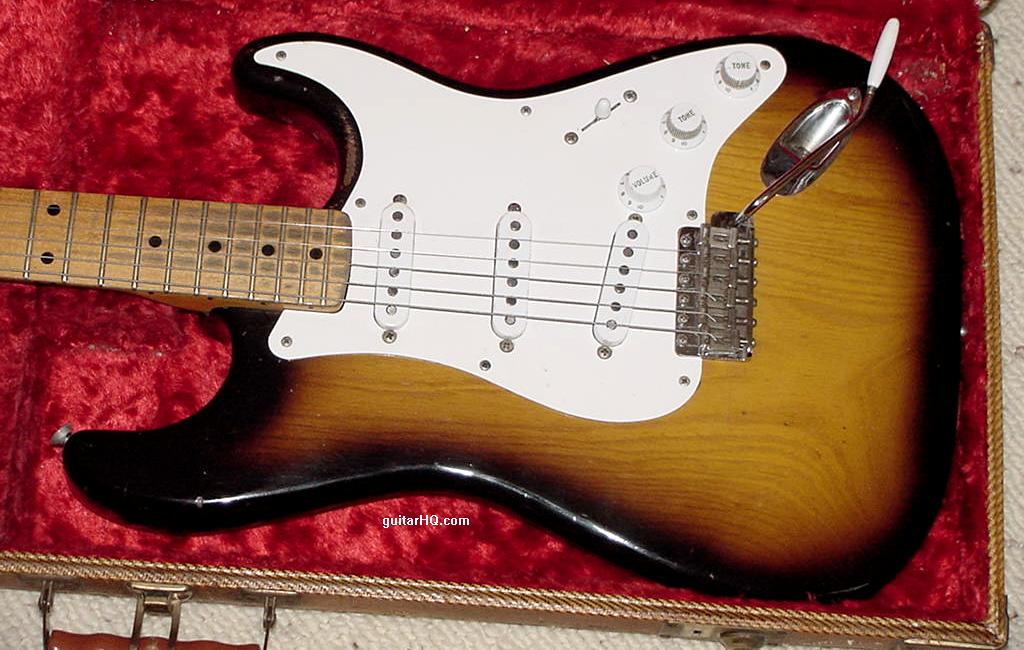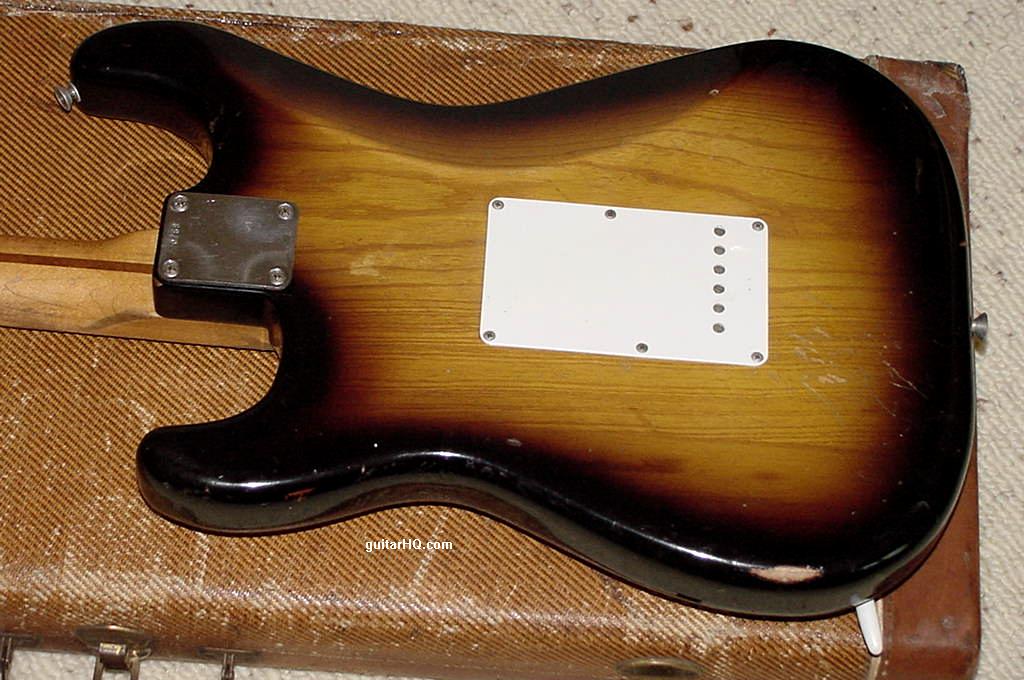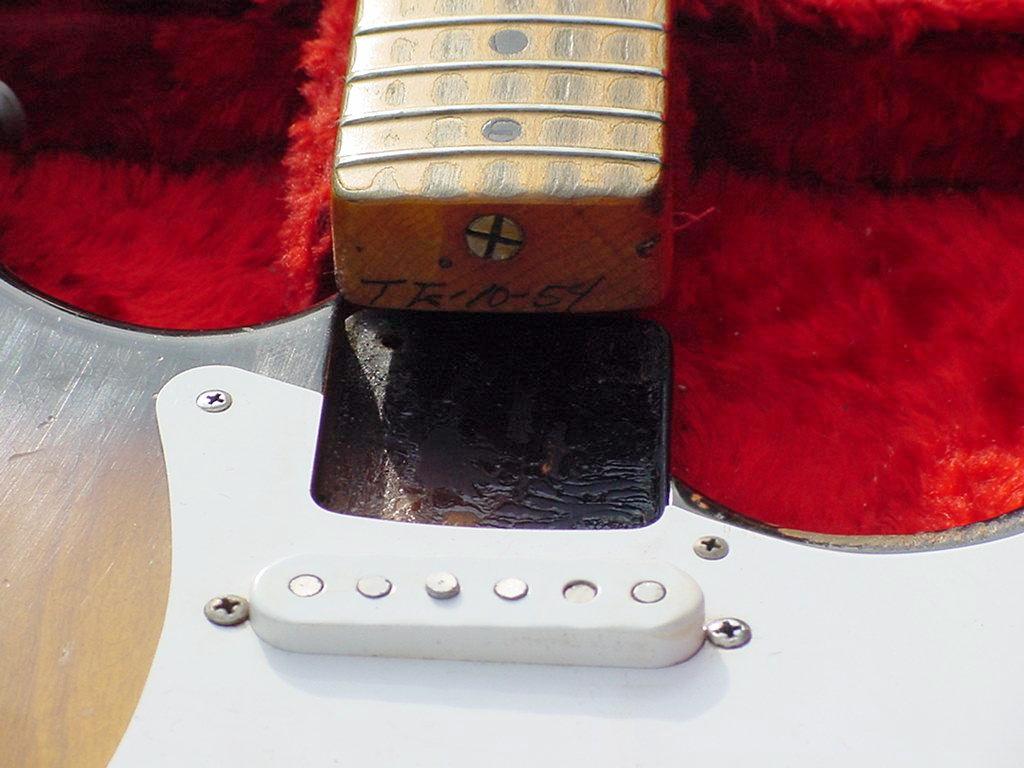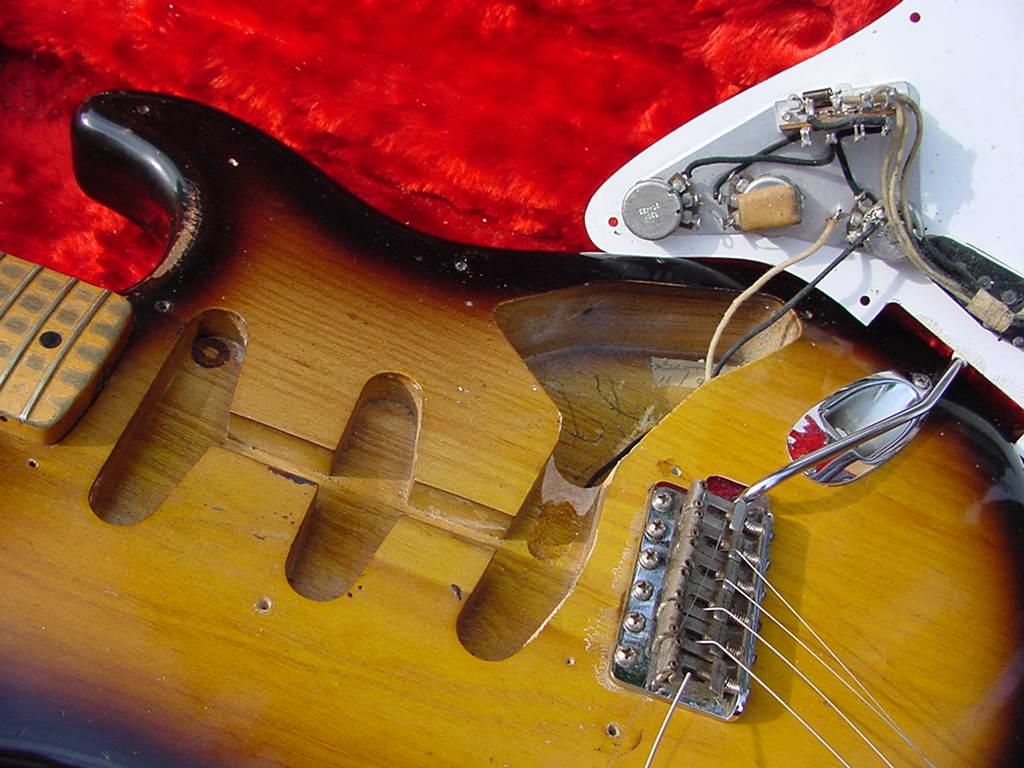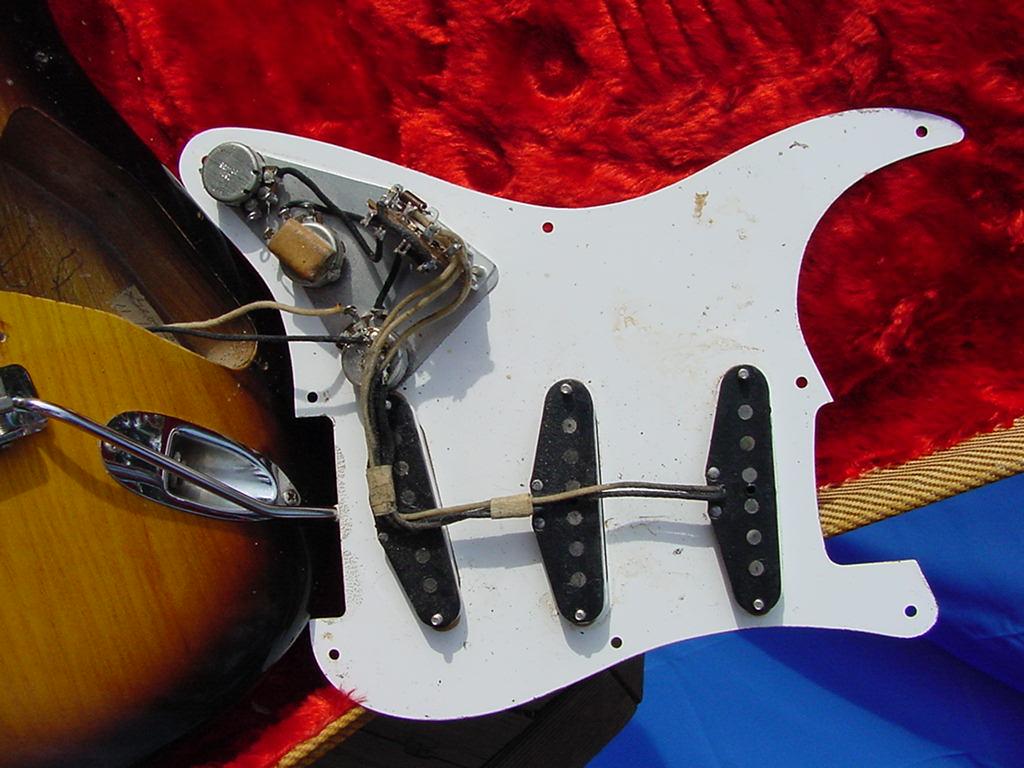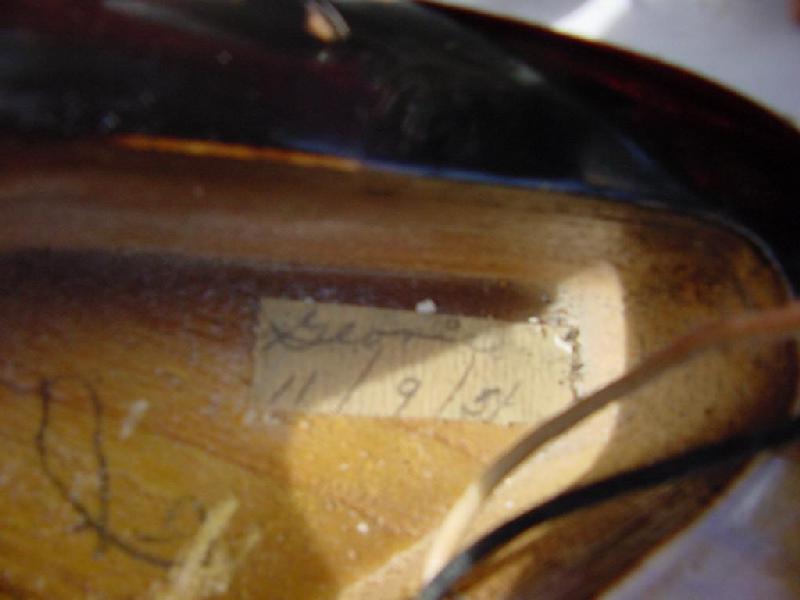Description: 1954 Fender Stratocaster guitar
Available: 1954 to present.
Collectibility Rating: A+
Production: no official (or unofficial) production numbers available.
General Comments:
The Fender Stratocaster guitar is probably the most popular solidbody electric
guitar ever made. Early models (1954 to 1965, known as "pre-CBS" models, since CBS
Broadcaster Company bought Fender in January 1965) are the most collectible.
Originality and condition are the two most important features of a vintage Fender
Stratocaster guitar, and Fender Strats do seem to have been easily modified
(due to their "bolt together" nature).
The 1954 Fender Stratocaster is of course the beginning of the breed. Full factory production of the Fender Stratocaster started October 1954. Stratocasters made from March 1954 to September 1954 were really hand-made prototypes, and the Strat's features did not "settle" until October 1954 (as you can see from the 1954 features listed below). The March to September 1954 models are the most interesting because of the unique prototypical features Fender was experimenting with (mostly related to plastic parts, which were different prior to October 1954), and the guitar's hand-crafted look and feel.
Serial number range for the 1954 Fender Stratocaster are generally 0001 to 7xxx (on the neck plate, though the first one hundred or so 1954 Strats had the serial number stamped into the rear plastic tremolo cover, with the trem plate serial numbers ranging from 0100 to 0207.) If you need to figure out the exact year of your pre-CBS Fender Stratocaster, use the serial number and the general features of the guitar. Beyond the first hunderd or so 1954 Strats, the serial number is located on the back metal neck plate. See the Fender Serial Number Info web page for help determining the year. Though Fender production numbers are not available, some research has shown that 268 Fender Strats were made during late 1954 (there were more than this made, because the 268 only includes the fall 1954 "regular production" numbers). Others have speculated as many as 1300 Strats in total were made in 1954. But neither set of numbers are confirmed, they are just guesses based on serial numbers seen. No one really knows the exact number of 1954 Strats manufactured.
Prior to the fall 1954 Stratocaster standard production and after the tremolo plate serial number Strats (May 1954 to September 1954), these guitar all have four digit serial numbers on the neck plate in the 0001 to 09xx range. These are still pre-production Strats with early "bakelite" mini-skirt knobs, just the serial numbers are 4 digits and on the neck plate, and are generally pretty low (0001 to 09xx approximately.) Starting about October 1954 "regular production" Strats started. These had serial numbers in the 0600 to 12xx range. Then in December 1954 serial numbers on Strats jumped numbers to the 6000 to 7xxx range.
If you have a vintage pre-CBS Fender Stratocaster guitar for sale, please let me know. I am a private vintage guitar collector (not a store), and you can contact me at cfh@provide.net
See the next year's 1955 Fender Stratocaster guitar.
Back to the main Fender Vintage Guitar Info webpage
March 1954 Fender Stratocaster introduction guitar specs:
- First 100 Strats (or so) made have the serial number pressed into the back plastic tremolo plate (0100 to 0207.) Serial numbers all four digits and starting with zero. The following several bullet points only applies to these models. The trem cover serial number models all have late May 1954 assembly dates and earlier.
- Introduced about late March 1954. Some 3/54 Strats have been seen and are prototype Strat bodies using three spring rear tremolos, instead of five springs; Also the route for the three springs was much narrowier (the "official" full production release of the Strat happened about October 1954).
- Extremely contoured ash body.
- Sunburst finish very crude. In fact, it's a "one color" sunburst finish. The center part of the sunburst is natural ash with no yellow - Fender only sprayed the dark brown around the edges of the body to give the sunburst look. This type of sunburst only appears on early Strats with the serial number on the rear plastic tremolo cover.
- Volume and tone pots 100k ohms, solid brass shaft pots, usually made by Stackpole (code 304).
- Plastic white pickup covers and "mini-skirt" knobs have a marbelized translucent look.
- Pickup height rubber grommets are often black instead of translucent brown. (Note the pickup rubber grommets are just surgical tubing cut into 3/8" lengths.)
Early 1954 Strat tremolo plate serial number:
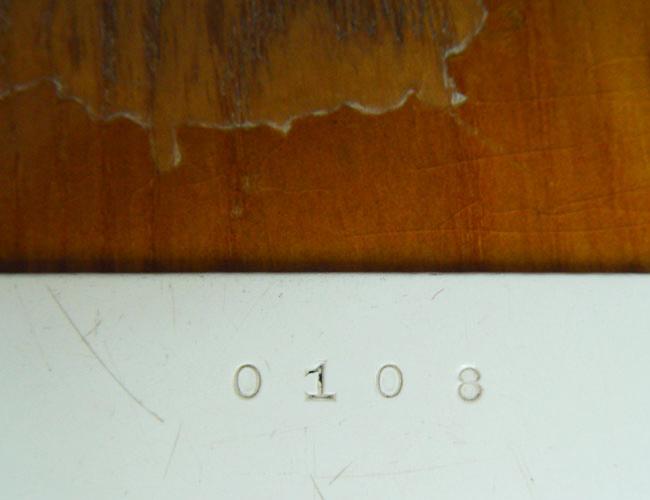
May/June 1954 Fender Stratocaster guitar specs:
- Extremely contoured ash body, two-color ("Canary yellow" to "Amber brown") sunburst finish with the center yellow color sprayed (custom colors Strats were also made in 1954).
- 4-digit serial number on metal neck plate starting with "0001".
- Thin "spaghetti" peghead decal logo, no patent numbers.
- "Small" peghead, round string tree, truss rod adjusts at butt.
- Neck attaches with 4 bolts and a metal neckplate.
- Rear tremolo back plate (white single layer .060" plastic) has round string holes.
- Volume and tone pots changed to 250k ohms. This seemed to happen sometime in June 1954. Still solid brass shaft pots, usually made by Stackpole (code 304).
- Often a piece of masking tape is seen in the control cavity with the final assembly person's signature. Most often seem is "Mary" as in Mary Lemus, a Fender factory employee (Mary began work at Fender in 1954 as an assembler, eventually becoming a final assembly supervisor). Also seen very often is "Gloria" as in Gloria Fuentes, another Fender factory employee assembler.
- Neck is one piece of maple with black dot position markers. Walnut "skunk stripe" down back of neck where truss rod was installed.
- Single layer, white ABS .060" thick pickguard with 8 attachment screws (ABS was a new material in the 1950s). Back of the pickguard is matte finished until about 10/54, when the back of the pickguard changes to a gloss finish.
- A small aluminum sheilding plate is installed underneath the pickguard that covers the control cavity.
- Pickups have two very small "tits" in the bottom black fiber part of the pickup on the outside edge around the two wire eyelets. Also there is a very faint ring pressed into the black fiber that goes around each eyelet.
- White "bakelite" plastic knobs and pickup covers. These knobs are actually not Bakelite but are Polystyrene thermoplastic (think those plastic model kits you assembled as a kid with the smelly glue). First generation: early 4/54 to 7/54 Stratocasters have different knobs and pickup covers. These are marbelized and a bit translucent. This is seen mostly on the thinner plastic pickup covers than on the knobs, and the amount of translucency varies from guitar to guitar. Some pickups covers are so translucent the black pickup bobbins can be seen through the covers. Also the pickup covers had rounded edges even when they were brand new. The volume/tone knobs are a different shape too, known as "tallboys" or "mini-skirts", being slightly taller and slimmer with the numbered skit being a much smaller variant of the famous 9/54 and later plastic Stratocaster knob. There were no "spokes" on the underside of these volume/tone knobs. The mini skirt bakelite knobs were mounted on smooth solid shaft potentiometers too (the 9/54 and later conventional Strat knobs were mounted on knurled split shaft pots). The shape of the 3-way switch tip resembled a symmetric "football".
- White "bakelite" plastic knobs/covers, second generation (7/54 and 8/54 only): all Strat plastic parts used the same molds as the "first generation" plastic parts, but the plastic itself is different. Now the plastic is completely opaque, with no translucent or marbeling effect (the prior translucent effect is seen mostly on the pickup covers). Also the plastic is very white and stays very white (it does not yellow much with age, unlike the 1957 and later "vinyl" (actually ABS) plastic part - note the first generation Strat plastics don't really yellow much either.)
- White "bakelite" (actually Polystyrene) plastic knobs/covers, third generation (9/54 to spring 1957): The plastic used on these "bakelite" knobs is the same as the second generation, but a new mold and knob shape was used. The new molds included the volume/tone knobs, 3-way switch tip, and the pickup covers (the tremolo tip didn't seem to change shape). Because the earlier mini-skirt volume/tone knobs had problem with the skirt breaking (because it was so petite and thin), Fender changed the knobs to the now-famous standard Stratocaster knob shape. The skirt was larger, and had three "spokes" on the under-side of the skirt to provide support. These knobs too cracked easily, but in general they did not self-destruct like the mini-skirt versions. Also the pots used with the third generation bakelite volume/tone knobs had a split shaft instead of a solid shaft. And the pickup covers were changed slightly to sharp edges (to increase strength, but often the sharp edges would round due to player wear). Also the switch tip "football" changed to a pear shape.
- The tremolo tip basically stayed the same shape for all three generations of Stratocaster plastic. The only noticible difference is the slight translucent plastic look the tremolo tip had from 4/54 to 7/54 during the first generation plastic parts era.
- Tremolo metal bar has strong exagerated bends.
- Steel 2 piece tremolo, with 6 adjustable saddles. Each nickel plated saddle is stamped "Fender Pat Pend" (note reissue models are stamped "Fender Fender"). The "Fender Pat Pend" is very faint (until about 1962). Also the front edge of the saddle (closes to the nut) is shorter in 1954. The Strat was available without tremolo (known as a "hardtail" model) by special order only (and in this case, a special order non-trem Strat is worth way less than the much more common "trem" model).
- Tremolo block's string-end ball holes are more shallow. These holes were deepened around fall 1954 to accomodate larger string-end balls. Also the side edges of the tremolo block were very rounded. This changed in 1955 to be less rounded.
- Neck backshape feel was a large rounded "D" style neck. The fingerboard had a 7.25" fingerboard radius with small (.078" wide) frets.
- Edges of the peghead rounded. This stoped by 1955 with the peghead edges becoming much sharper at the edges.
- Sometimes the under-the-pickguard route for the lead pickup does not have the wire channel route until about summer 1954, when Fender added a shallow wire channel route in the lead pickup cavity. Because this proved to be a problem, often a hand chiseled wire channel was added to the Strat body by the final assembly person. This is easy to identify as there is no paint in this crudely hand chiseled wire channel in the bottom of the lead pickup route. This is most often seen in mid to late 1954 Strat bodies. Also the 1954 bridge pickup wire route is not as deep as on 1955/56 and later models, so sometimes this route is crudely deepened with a hand chisel during final assembly.
- 3-way CRL switch has three patent numbers. The bakelite plate that holds the switch contacts has angled sides.
- "No Line" Kluson Deluxe tuners (which do not say "Kluson Deluxe).
- "Bobby Lee" style strap included with the guitar. The padded portion of the strap is rectangle. 1955 and later Strat straps have the padded portion banana-shaped. Pre-CBS black Strat straps do not have a "Fender" logo on the strap buckle.
October 1954 Fender Stratocaster "production" guitar specs:
- Now the strat is considered to be "production" and it's characteristics are gelled and more consistent. Guitar is now an assembly-line produced instrument and has less "hand made" inconsistencies. Forrest White insisted that any Stratocasters produced before October 13, 1954 were "pre-production samples" or "artist models" (and were probably all sold directly to musicians from the Fender factory instead of through Fender Sales). The reason for this was purchase order PO #242 from Fender Sales for about 100 Strats, which was finished and delivered on October 13, 1954. After this point Fender Sales (a different company than Fender Musical Instruments) handled all sales of Stratocasters, and technically no units were available directly from the factory. Models available before October 1954 were often "demonstrators" brought to music store to be shown off, and sometimes sold.
- Pots are split shaft 250k ohms, usually made by Stackpole (code 304).
- Channel route or wiring in lead pickup cavity is usually more "factory" looking and has finish over the route (but even late 1954 Strats can still have the lead pickup wiring "worm route" done during final assembly, showing bare wood with no finish).
